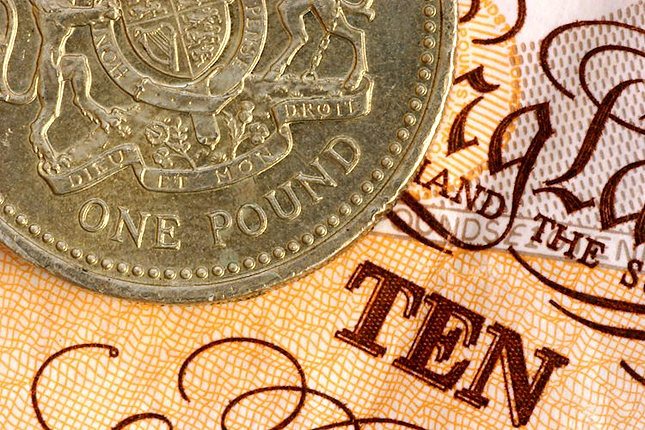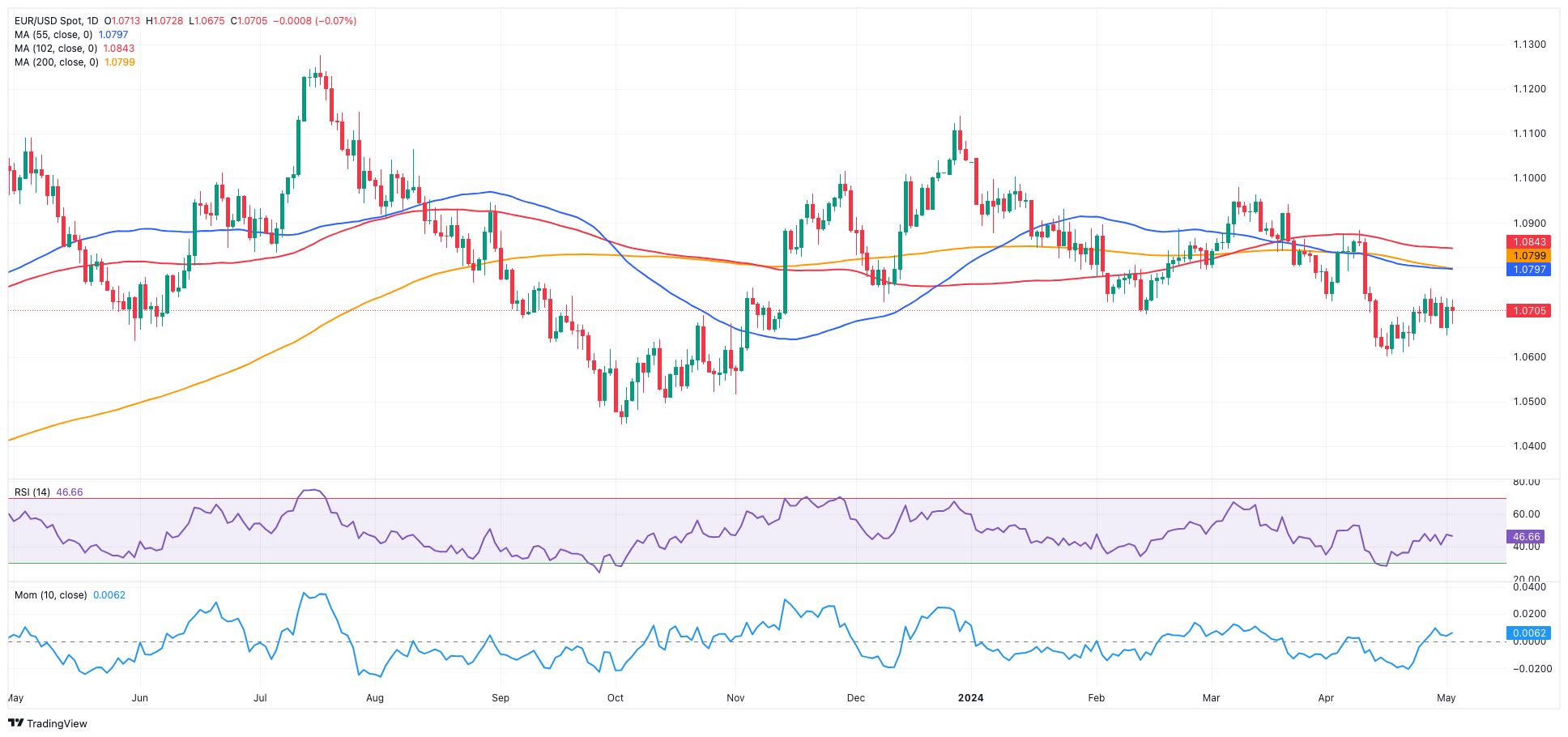- EUR/USD maintained its consolidative theme around 1.0700.
- The US Dollar alternated gains with losses post Fed’s rate decision.
- The upcoming NFP should add to speculations around the timing of rate cuts.
The US Dollar’s (USD) inconclusive price action sparked an equally vacillating move in EUR/USD on Thursday, always surrounding the 1.0700 neighbourhood.
This irresolute momentum of the Greenback came pari passu investors’ assessment of the latest Federal Reserve's (Fed) decision to maintain its interest rates unchanged at 5.25%-5.50% on Wednesday.
In that event, it is worth recalling that the Committee reaffirmed its stance on the Fed Funds Target Range (FFTR) at 5.25%–5.50%, expressing intentions for rate cuts but expressing concerns about inflation and potential disruptions in economic equilibrium. Additionally, the central bank announced intentions to slow down the pace of balance sheet reduction, contrasting with previous warnings.
In addition, Chair Jerome Powell's remarks further weighed on the Dollar, as he argued that the next policy adjustment is unlikely to involve a rate hike.
In the longer term, weakness in the US Dollar is expected to be temporary due to delayed expectations of a potential interest rate cut by the Federal Reserve (Fed) later this year.
Meanwhile, US yields maintained their decline, while the broader macroeconomic landscape kept pointing to the divergence in monetary policies between the Fed and other G10 central banks, particularly the European Central Bank (ECB).
Recent statements from ECB board members suggested the possibility of the ECB initiating its easing cycle in June, sparking speculation about three interest rate cuts (or 75 basis points) for the remainder of the year.
Looking ahead, the relatively muted economic fundamentals in the Eurozone, along with the resilience of the US economy, reinforce expectations for a stronger Dollar in the medium term, especially considering the increasing likelihood of the ECB cutting rates well before the Fed.
In this context, EUR/USD is anticipated to undergo a more pronounced decline in the medium term.
EUR/USD daily chart
EUR/USD short-term technical outlook
On the upside, EUR/USD is projected to face first resistance at the weekly high of 1.0752 (April 26), which comes before the significant 200-day SMA of 1.0798 and the April top of 1.0885 (April 9). North from here comes the March peak of 1.0981 (March 8), followed by the weekly high of 1.0998 (January 11), all before reaching the psychological barrier of 1.1000.
Looking south, a break of the 2024 low of 1.0601 (April 16) might indicate a return to the November 2023 low of 1.0516 (November 1), which precedes the weekly low of 1.0495 (October 13, 2023). Once this region is achieved, a trip to the 2023 bottom of 1.0448 (October 3) is feasible before achieving the round milestone of 1.0400.
The 4-hour chart indicates some consolidation, with the pair currently targeting 1.0752, ahead of the 200-SMA at 1.0756. Meanwhile, 1.0673 offers early support, ahead of 1.0601 and 1.0516. The relative strength index (RSI) rose past 52.
Information on these pages contains forward-looking statements that involve risks and uncertainties. Markets and instruments profiled on this page are for informational purposes only and should not in any way come across as a recommendation to buy or sell in these assets. You should do your own thorough research before making any investment decisions. FXStreet does not in any way guarantee that this information is free from mistakes, errors, or material misstatements. It also does not guarantee that this information is of a timely nature. Investing in Open Markets involves a great deal of risk, including the loss of all or a portion of your investment, as well as emotional distress. All risks, losses and costs associated with investing, including total loss of principal, are your responsibility. The views and opinions expressed in this article are those of the authors and do not necessarily reflect the official policy or position of FXStreet nor its advertisers. The author will not be held responsible for information that is found at the end of links posted on this page.
If not otherwise explicitly mentioned in the body of the article, at the time of writing, the author has no position in any stock mentioned in this article and no business relationship with any company mentioned. The author has not received compensation for writing this article, other than from FXStreet.
FXStreet and the author do not provide personalized recommendations. The author makes no representations as to the accuracy, completeness, or suitability of this information. FXStreet and the author will not be liable for any errors, omissions or any losses, injuries or damages arising from this information and its display or use. Errors and omissions excepted.
The author and FXStreet are not registered investment advisors and nothing in this article is intended to be investment advice.
Recommended Content
Editors’ Picks

EUR/USD retreats from tops post-US PCE, back near 1.0540
The bearish sentiment in the US Dollar remains in place and supports EUR/USD's constructive outlook, keeping it in the 1.0540 region after the release of US inflation data, as measured by the PCE, on Wednesday.

GBP/USD recedes to 1.2640 on US PCE data
GBP/USD remains positively oriented in the 1.2640 zone as the Greenback experiences a marked pullback following the PCE inflation release.

Gold remains sidelined near $2,640 following US inflation prints
Gold remains on the positive foot near $2,640 per troy ounce, as US inflation data matched initial estimates in October, while US yields display a negative performance across the curve.

The clock is ticking for France
A French political problem is turning into a problem for financial markets. The budget deficit in France is 6% of GDP, if the planned reforms are not enacted, then the deficit could rise to 7% of GDP next year. This is the level when bond vigilantes start to sniff around.

Eurozone PMI sounds the alarm about growth once more
The composite PMI dropped from 50 to 48.1, once more stressing growth concerns for the eurozone. Hard data has actually come in better than expected recently – so ahead of the December meeting, the ECB has to figure out whether this is the PMI crying wolf or whether it should take this signal seriously. We think it’s the latter.

Best Forex Brokers with Low Spreads
VERIFIED Low spreads are crucial for reducing trading costs. Explore top Forex brokers offering competitive spreads and high leverage. Compare options for EUR/USD, GBP/USD, USD/JPY, and Gold.
